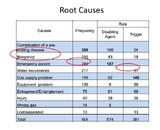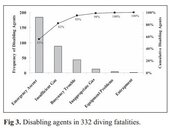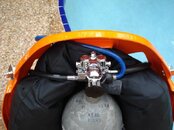You are using an out of date browser. It may not display this or other websites correctly.
You should upgrade or use an alternative browser.
You should upgrade or use an alternative browser.
DiverGuard looks for skeptics bloggers/reporters
- Thread starter DiverGuard
- Start date
Please register or login
Welcome to ScubaBoard, the world's largest scuba diving community. Registration is not required to read the forums, but we encourage you to join. Joining has its benefits and enables you to participate in the discussions.
Benefits of registering include
- Ability to post and comment on topics and discussions.
- A Free photo gallery to share your dive photos with the world.
- You can make this box go away
DevonDiver
N/A
I hope that you understand my position, and in case that you want to respond to it - please respond in a practical manner.
Here's something more practical. You will see that:
1) AGE is a primary disabling injury, causing diver death.
2) Diver death is often listed as 'drowning', but only subsequent to a primary disabling injury.
3) Uncontrolled emergency ascent and/or loss of buoyancy control is a primary cause of AGE.
4) Diving deaths can be reduced by preventing the primary disabling injury (i.e. AGE).
5) The trigger event (i.e. 'out-of-air') is not the primary cause of death (by drowning)
6) Most victims manage to reach the surface, before drowning.
7) Reaching the surface does not correspond with 'surviving' the incident.
8) A slow, controlled ascent significantly reduces AGE risk.
9) Reaching the surface without a disabling injury (i.e. AGE) is critical to survival.
10) A fully inflated BCD, uncontrolled on ascent, leads to ascent speeds from 21 to 77m per minute (depending on BCD volume).
11) Divers would be unable to sufficiently protect their lungs at extreme ascent speeds.
From this, we can interpret that:
1) Controlled, rather than uncontrolled, ascent is significant in reducing diver fatality, through prevention of disabling injury (AGE).
2) Most divers can reach the surface - the critical factor to survival is whether they suffer a disabling injury during that ascent.
3) Your device prevents controlled ascent, leading to uncontrolled highly buoyant ascent, greatly increasing the risk of disabling injury (AGE).
4) Whilst getting the victim to the surface, your device will ultimately contribute to lowering their chance of survival (by increasing risk of disabling injury and consequent drowning at the surface).
Don't even get me started on DCS risk...
DAN. Theory Into Practice - Emergency Ascents: Managing the Risks
"In a recent analysis of 964 diving fatalities, we found that emergency ascents were involved in 30 percent of cases — 288 to be exact. In 189 of these emergency ascents, a rapid ascent (faster than 60 fpm) was witnessed or recorded. In 10 percent of emergency ascents, divers attempted a free ascent without using a breathing gas supply....The most frequent trigger of an emergency ascent is running out of breathing gas during the dive, an entirely preventable cause.
The most common cause of death in fatal emergency ascents is arterial gas embolism (AGE), accounting for 54 percent of cases, followed by drowning at 18 percent, acute cardiac events at 7 percent and decompression sickness at 5 percent. AGE is a stroke-like condition with sudden onset of weakness and unconsciousness that usually occurs within minutes of surfacing. It often renders a diver unconscious before he gets out of the water or soon after.
..You received training on how to do emergency ascents in your original certification course. Remember the preferred order of options:
- Make a normal controlled ascent, with your regulator in your mouth.
- Find your buddy and obtain his secondary air source (or his primary if he will be taking the secondary, depending on the configuration of his gear). The goal in this scenario is for both divers to have a continuous air source, enabling you both to make a slow, controlled ascent to the surface.
- If you cannot reach your buddy or another diver, or if your buddy is also out of air, complete a controlled emergency ascent on your own. But again, don't panic. Remember, you likely have enough air in your lungs to sustain you to the surface. Follow the procedures you learned in training: Keep your regulator in your mouth at all times; sometimes air expands and gives you one more quick breath. Exhale slowly and continuously all the way to the surface, and keep your ascent slow."
1) AGE kills more people on emergency ascents than drowning.
2) Every taught and recommended response includes a "slow, controlled ascent" to the surface.
Your device contradicts the training and advice given. It increases risk of AGE by preventing slow, controlled ascent.
Further practical contribution:
"AGE [arterial gas embolism] secondary to PBT [pulmonary barotrauma] is one of the leading causes of death in the recreational diving community.....improvements in dive gear reliability (buoyancy compensating jacket, air pressure gauge, etc.) and the evolution of diving practice (air pressure monitoring,“ buddy diving ” system, etc.) have limited the number of “ out-of-air ” situations requiring an EFA (Emergency Free Ascent)."
Pulmonary Barotrauma in Divers During Emergency - Free Ascent Training: Review of 124 Cases in Aviat Space Environ Med 2009; 80: 371 – 5 .
From: Common Factors in Diving Fatalities, DAN America and DAN Europe Data, Fatality Workshop, Durham April 8-10, 2010..

"Most common causes are gas supply problems, emergency ascent, cardiac health issues, entrapment/entanglement, and buoyancy issues."
So, whilst your device does nothing to prevent the other factors occuring, it significantly increases risk of emergency ascent and buoyancy issues. It contributes towards a huge risk to the diver from two of the most recognized factors contributing to diving fatalities.
"...common patterns were frequent as the following examples illustrate.
(a) A diver ran out of gas, made an emergency ascent, developed an arterial gas embolism (AGE) in the water, and drowned. Insufficient gas was the trigger, emergency ascent was the disabling agent, AGE was the disabling injury, and drowning was the COD [cause of death]."
"Disabling Injuries
Of the 947 cases, a COD was assigned by the medical examiner in 814, and drowning was cited as COD in 70% of these. For the majority of those who drowned, however, there was evidence that the prior disabling injury may have incapacitated the decedent. Thus, we elected to focus on the disabling injury as more
relevant to diving safety than the subsequent COD, drowning."

From UHM 2008, Vol. 35, No. 6 – Causes of Recreational Diving Fatalities
"AGE as Disabling Injury
AGE was assigned as the disabling injury in 171 of 590 cases for which a disabling injury could be identified. Triggers were identified in 82 of the 171 AGE cases (Table 3b) and included insufficient gas (63%), equipment trouble (17%), and entrapment or entanglement (9%). Case review indicated that approximately three-quarters of AGE deaths were triggered when divers exhausted their breathing gas, panicked, or developed equipment problems.
Disabling agents were identified in 139 of the 171 AGE cases with emergency ascent (96%) most common. Loss of consciousness during ascent, at the surface, or just after leaving the water was typical with AGE, and drowning as COD was secondary for many divers who remained in the water. For 55 of the 171 AGE cases, for example, the COD was reported as drowning suggesting that divers disabled by AGE were at risk of drowning."
"Implications for Diving Safety
Not surprisingly, analysis of diving fatality case data identified many triggers and disabling agents that are the focus of existing diving safety guidelines (44-46). What is new is recognition that a majority of fatalities were associated with a minority of triggers and disabling agents. This suggests that diving fatalities might be reduced by additional emphasis on the prevention of key triggers, disabling agents, and intrinsic medical factors"
"Emergency ascent (55%) was the most prominent disabling agent in response to an initiating trigger (Fig. 3). While preventing triggers is a top priority, coping with unavoidable emergency ascent would break the sequence of Fig. 1 and perhaps avoid a fatal outcome"
And....the issue of ascent speed...
"A study at the University of California demonstrated these excessive ascent rates. Divers wearing full ocean gear, which included 7 mm wetsuits, were weighted for neutral buoyancy and then positioned horizontally at a depth of 9.4 feet/2.85 meters, holding onto a weighted box. After their BCDs were fully inflated, the divers let go and ascended to the surface. Their position changed from horizontal to vertical on the way up. The BCDs tested had lifts of 11.2-54.8 pounds/5.1-24.9 kilograms.
Average ascent rates varied from 68 feet per minute (fpm)/20.6 meters per minute (mpm) with the smallest BCD, to 168 fpm/50.9 mpm with the largest. The maximum ascent rate generally occurred in the last meter or so, and reached a frightening 254.8 fpm/77.2 mpm with the largest BCD. This is certainly much faster than the generally recommended ascent rates."
The Ups and Downs of Buoyancy Control, by John Lippmann Executive Director DAN S.E. Asia-Pacific
"Divers Alert Network studied almost one thousand diving fatalities and they determined that the root cause of the triggering event was usually one of the following five factors:
- Some sort of pre-existing disease pathology in the diver.
- Poor buoyancy control.
- Rapid ascent or violent water movement.
- Gas-supply problems.
- Equipment problems."
FromFatalities: Inexperience a Big Factor, By Dr. David Sawatzky
I'd suggest that 'DiverGuard' led to poor buoyancy control, rapid ascent AND was an equipment problem.
"AGE was often reported by medical examiners as a contributing factor in cases classified as drowning, but when disabling injuries (Figure 5) rather than COD (Figure 3) were examined, AGE was found to be involved in many fatalities with drowning as the COD. Not unexpectedly, most AGE cases were associated with emergency ascent (odds ratio (OR)>30)."
DAN Recreational Diving Fatalties, Workshop Proceedings, 2010
Wookie
Proud to be a Chaos Muppet
Staff member
ScubaBoard Business Sponsor
ScubaBoard Supporter
Scuba Instructor
I'd stop breathing underwater. Just to hear the alarm, over and over again.Perhaps the audible alarm could be replaced with Sigourney Weaver's voice.
jadairiii
Contributor
- Messages
- 1,376
- Reaction score
- 2,101
There is nothing new here in principle, Watergill (later Seapro) had the same idea in 1976. The FSDS-100 regulator, but their system was purely mechanical in the first stage of the regulator. Stop breathing, the built in HP creep would build up and bypass your airway on your At-Pac, inflating your At-Pac and sending you to the surface. At the surface it would continue to inflate and honk, alerting (hopefully) the dive boat/buddy.
Anyway, I believe Seapro stopped producing that regulator sometime prior to the 1980s. Now the idea lives again, rising from the ashes of Watergill/Seapro like a Phoenix!
Anyway, I believe Seapro stopped producing that regulator sometime prior to the 1980s. Now the idea lives again, rising from the ashes of Watergill/Seapro like a Phoenix!
Attachments
1bubbleoff
Contributor
Dear Diverguard-
Is a Lifetime DAN membership and personal travel recompression chamber included in the list price?...
Is a Lifetime DAN membership and personal travel recompression chamber included in the list price?...
Interesting concept. I am with the majority here and I think I would just stick with the current system. Might be a good tool for disabled divers or other groups who may be at a higher risk for passing out... In my mind for myself, if it aint broke, dont fix it...
As we all very well know, buoyancy issues are common. Soon someone will present a device that automates depth changes. This would certainly increase the flow of customers and profit margins.
"Set target depth - Confirm"
(and pray that it was in feet)
"Set target depth - Confirm"
(and pray that it was in feet)
I saw this at DEMA last year. They had quite a large booth so they must have sold this concept to some investors who never dive. After finding out what it did, my buddy and I RAN away from that booth. It's hard to believe that anyone would seriously consider using this. I will give them full credit for selling the idea to either an Angel or VC firm that will eventually (if not already) chalk this up in the loss column.
but... but.... but... :doh:
Or they could sell it to turkey hunters. Personally along with highly dangerous concept is the sheer size of the damn thing. Like putting a friggin brick on your inflator hose. If I wanted to junk a BC up with something like that I'd put an integrated inflator on it.
Similar threads
- Replies
- 4
- Views
- 2,361
- Replies
- 0
- Views
- 410
- Replies
- 13
- Views
- 614
- Replies
- 16
- Views
- 1,640
- Replies
- 30
- Views
- 2,821




